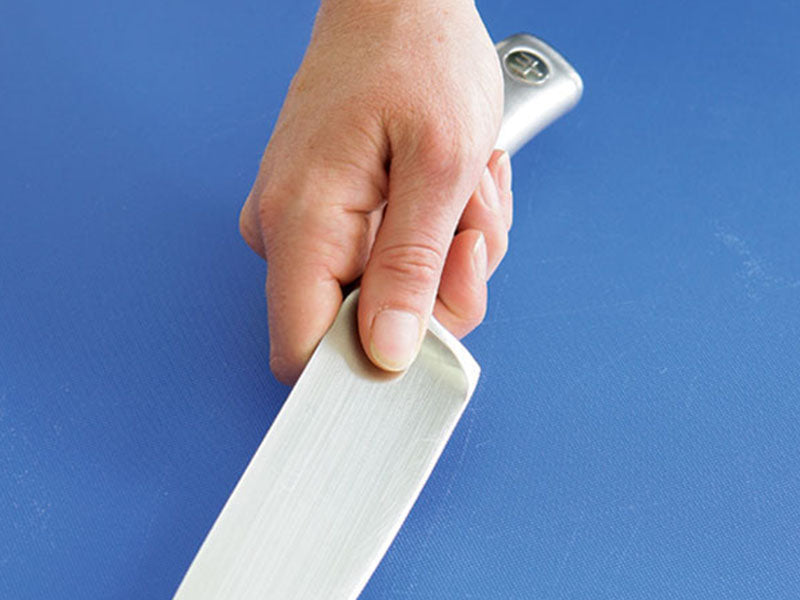As one of our editors likes to say, a chef’s knife “is like a dance partner.” A knife that feels comfortable and graceful in your hand might feel klutzy to someone else. When you start shopping for that perfect chef’s knife—one that will make slicing, dicing, chopping, and mincing more pleasurable, precise, and effortless—it’s important to identify your personal preferences, and to realize that there isn’t one knife that’s right for everyone. Finding your ideal knife might take a little time, but you’ll know it when you’ve found it.
Where to meet your match
The first step to finding a chef’s knife that works for you is to search out a cutlery or cookware store (rather than an online or mail-order source) with a wide selection of sample knives that you can hold or, even better, maneuver on a cutting surface. “You can’t buy a knife off a peg board. You need to feel it and talk to someone who can guide you,” says Jacob Maurer, a cutlery buyer for Sur La Table, which lets customers chop food with their knife samples. Seek out salespeople who can lead you to a knife that fits; don’t fall prey to those who tell you which knife to buy.
Another shopping tip: Have an open mind. Richard Von Husen, owner of Warren Kitchen and Cutlery in Rhinebeck, New York, has customers “play” with a range of knives without looking at price to determine the size, shape, and weight of knife that they prefer. Then he helps narrow the choices down to those within the customer’s budget.
Wherever you buy your knife, ask if you can return it if it feels dull or isn’t the right fit after a short test drive at home (just don’t ding it or wear down the blade). For ideas on what tasks will best help you to evaluate a knife, see “How to test,” below.
How to test
In choosing some of our favorite knives (below), the Fine Cooking test kitchen ran more than two dozen models through this battery of tasks. If possible, try using your favorite few knives to:
- Mince parsley
- Dice an onion
- Slice winter squash
- Cut carrots into thin strips
- Carve a melon
What to look for in a knife
Once you’ve got a knife in your hand (see photo above for proper grip) you should immediately get a sense of its fit. It should feel comfortable, like a natural extension of your hand. It should inspire confidence, not instill fear. If it feels wrong, move on. If it feels pretty good, start chopping (or mock chopping), noting how you respond to the knife’s physical characteristics.
- Weight: You’ll need to try several knives to find your ideal knife weight. One school of thought believes a hefty chef’s knife cuts through foods easier because it “falls” with more force. Another thinks a lighter chef’s knife flows more freely and lets you maneuver the knife more skillfully. Bottom line: Choose the style that feels right to you.
- Balance: “Perfect balance” is in the palm of the beholder. Judge balance by gripping the knife by its handle. If it feels uncomfortably weighted toward the back of the handle or toward the blade, then it probably isn’t for you. An unbalanced knife will make you work harder. Side-to-side balance is also important. When you come down on the blade, the knife shouldn’t feel unstable, as if it wants to teeter toward one side or the other.
- Size: An 8-inch chef’s knife is the most popular among home cooks because of its versatility. A 10-incher’s longer blade can cut more volume but may feel intimidating. A 6-inch chef’s knife can offer an element of agility, like that of a paring knife, but falls short when working with volume or when slicing through something large, like a watermelon.
Anatomy of a chef’s knife

The handle: A good handle is one that feels comfortable and secure to you. You shouldn’t have to strain to hold onto it, and it shouldn’t feel slippery when wet. There should be enough clearance on its underside that you don’t bang your knuckles as you chop (the height of the blade affects this). Some knives’ handles have molds or indentations to facilitate grip. These work for some people. For others they force an unnatural grip and make the knife hard to hold at awkward angles, such as when butterflying a chicken breast or carving a melon.
The bolster: Also called the collar, shoulder, or shank, the bolster is the thick portion of metal where the blade and handle meet. The bolster can add strength and stability to a knife as well as act as a finger guard for your gripping hand. Some forged knives have only partial bolsters, which don’t extend all the way to the blade’s heel, and some knives, especially Japanese-style knives, have no bolster at all. An advantage to partial- or no-bolster knives is that you can sharpen the full length of the blade, right through the heel. As you hold a knife, notice the slope from the bolster to the blade. It may be pronounced or gradual, but neither style should make you feel like you have to tighten your grip.
The heel: Unless it’s a Japanese-style forged knife (see “What is a Japanese-style chef’s knife?” below), the heel is the broadest and thickest part of the edge with the greatest heft. It’s meant for tasks that require force, such as chopping through poultry tendons or the hard rind of a winter squash. Watch out for knives that “thunk” at the heel when rocked. The heel shouldn’t abruptly stop the rocking motion. Nor should it be so curved that the blade wants to kick backward.
The spine: This is the top portion of the blade, and it typically has squared edges. Note whether the edges feel polished or sharp and rough, which can potentially irritate your gripping hand. The spine should also taper at the tip; a thick tip will be hard to work with.
The edge: A good chef’s knife should be sharp right out of the box. To evaluate sharpness, try slicing through a sheet of paper. A really sharp knife will make a clean, swift cut. (Of course, if you have the opportunity, chop some food, too.) Also note the line of the blade. A gentle curve from the tip to the heel can help the knife smoothly rock back and forth during chopping and mincing.
What is a forged knife?
This article focuses on high-carbon stainless-steel chef’s knives, which are commonly made by hammering a red-hot billet of steel into a shaped die. Forged knives have a reputation for durability and balance. There are, however, excellent stamped chef’s knives laser cut from sheets of high-quality steel, as well as knives made from other materials like ceramics. See below for more information on ceramic knives.
Some of our favorite German-style chef’s knives

1. Chef’sChoice Trizor Professional
For a substantial knife, its noticeable weight really worked in its favor. Markedly sharp and with just the right blade height, it has a comfortable, nubbly-textured handle that’s easy to grip.
2. Friedr. Dick Premier Plus
More well known in commercial kitchens, Friedr. Dick makes a classic-style chef’s knife that’s well balanced and proportioned, sharp, and “doesn’t take a whole lot of effort to move.” The blade is nicely curved for a smooth, continuous rock.
3. Messermeister Meridian Elite
Our test kitchen manager succinctly summed this knife up as “sharp, swift, balanced, and just the right weight.” This knife has a partial bolster so that the edge can be easily sharpened along its full length. Its cousin, the Messermeister San Moritz Elite, with a seamless molded handle, was another well-liked knife.
4. Wüsthof-Trident Classic
As one editor noted, it’s “tapered in the right places and beefy in the right places” with “subtle details that make the knife work naturally for you.” Wüsthof’s Grand Prix II knife was also a favorite of many. It has the same blade but with a contoured, slip-resistant polypropylene handle.
What’s a Japanese-style knife?
There’s a growing trend toward “Japanese-style” knives, and even classic German knife makers are getting in on the act. A Japanese-style chef’s knife tends to be lighter and have a thinner blade than a German-style knife, making it highly maneuverable and adept at fine slicing. With the thinner blade, it also tends to be quite sharp.
But a Japanese-style chef’s knife isn’t the best for splitting a chicken or slicing through an acorn squash because it doesn’t have the beefy, wedge-like heel that’s needed for those tasks. Also, its edge tends to have a straighter profile (less curve) than a German-style knife, so it doesn’t always rock as smoothly.
Some of our favorite Japanese-style chef’s knives

1. Calphalon Katana
This knife had a soft, “incredibly comfortable” handle, despite a lack of bolster to nuzzle up against. It “encourages your hand to be in the right position, naturally,” noted one of our test cooks. The thin blade sliced adeptly, but a lack of curve made it less smooth at mincing and chopping.
2. Chroma Type 301
You’re apt to either love or strongly dislike this light knife. Some found it comfortable and very easy to hold and control with the “pearl” on each side of the handle providing a guide for knowing where your grip is. Others found the pearl feature irritating.
3. Global
This sleek knife has a thin, sharp blade that, to its many fans, felt amazingly skillful and precise. It’s very light—almost a quarter pound less than the heavier German-style knives. But the blade’s lack of curvature means it doesn’t rock so smoothly, and the knife’s lack of bolster, sharply angled heel, and thin handle felt precarious to even some of its strongest advocates.
4. Kershaw Shun Classic
Many really liked how this knife felt: slender, sharp, fluid, nicely balanced, and truly comfortable. For a Japanese knife, it had a “feeling of substance” yet was still “light on its feet.” Like other knives in this group, the lack of bolster may require some getting used to. This knife comes in left- and right-handed models.
How to Hone & Sharpen Your Knives
Once you have great knives, you want to take good care of them. You don’t need to sharpen your knife as often as you might think, but it does need regular honing. In our bonus videos, Institute of Culinary Education chef-instructor Norman Weinstein demonstrates the proper way to hone your knife on a steel, as well as sharpen it on a stone.


Curious about ceramic knives?

Knives made from superhard ceramic are available in an increasing variety of shapes and sizes—chef’s knife, santoku, paring. But what they have in common are their thin, incredibly sharp, and precise blades. The larger chef’s or santoku-style ceramic knives are the most versatile, making it a breeze to fillet salmon, carve steak, slice squishy, ripe tomatoes, and dice vegetables finer than you ever thought you could. Just as impressive, ceramic blades hold their sharp edge longer than steel. But ceramic knives are still more of a complement than a replacement for steel blades. Like Japanese-style knives, ceramics lack a bolster and a thick heel; you’ll want something heftier for hard squash, raw potatoes, and chicken bones.



Leave a comment
This site is protected by hCaptcha and the hCaptcha Privacy Policy and Terms of Service apply.